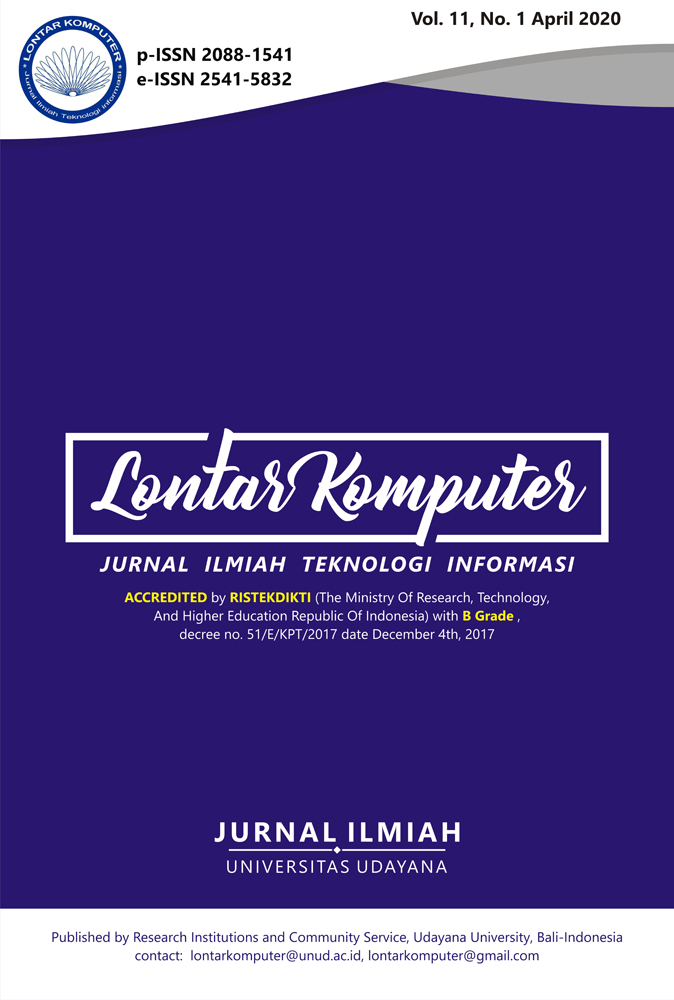Forecasting New Student Candidates Using the Random Forest Method
Abstract
College education institutions regularly hold new student admissions activities, and the number of new students can increase and can also decrease. University of PGRI Semarang (UPGRIS) on the development of new student admissions for the 2014/2015 academic year up to 2018/2019 with so many admissions selection stages. To meet the minimum comparison requirements between the number of students with the development of human resources, facilities, and infrastructure, it is necessary to predict how much the number of students increases each year. To make a prediction system or forecasting, the number of prospective new students required a good forecasting method and sufficiently precise calculations to predict the number of prospective students who register. In this study, the method to be taken is the Random Forest method. For the evaluation of forecasting models used Random Sampling and Cross-validation. The parameter used is Mean Absolute Error (MAE), Mean Squared Error (MSE), Root Mean Squared Error (RMSE), and Coefficient of Determination (R2). The results of this study obtained the five highest and lowest study programs in the admission of new students. Therefore, UPGRIS will make a new strategy for the five lowest study programs so that the desired number of new students is achieved
Downloads
References
[2] M. Irfan, L. P. Ayuningtias, and J. Jumadi, “Analisa Perbandingan Logic Fuzzy Metode Tsukamoto, Sugeno, Dan Mamdani (Studi Kasus : Prediksi Jumlah Pendaftar Mahasiswa Baru Fakultas Sains Dan Teknologi Uin Sunan Gunung Djati Bandung),” Jurnal Teknik Informatika, vol. 10, no. 1, pp. 9–16, 2018.
[3] A. S. Ritonga and S. Atmojo, “Pengembangan Model Jaringan Syaraf Tiruan untuk Memprediksi Jumlah Mahasiswa Baru di PTS Surabaya (Studi Kasus Universitas Wijaya Putra),” Jurnal Ilmiah Teknologi Informasi Asia, vol. 12, no. 1, p. 15, 2018.
[4] L. Nurhani, A. Gunaryati, S. Andryana, and I. Fitri, “Jaringan Syaraf Tiruan Dengan Metode Backpropagation,” in Seminar Nasional Teknologi Informasi dan Multimedia, 2018, pp. 25–30.
[5] S. Karmita, A. Bramanto, O. Gaffar, and A. S. Wiguna, “Prediksi Jumlah Calon Mahasiswa Baru Menggunakan Fuzzy Time Series-Time Invariant,” in Prosiding Seminar Ilmu Komputer dan Teknologi Informasi, 2018, vol. 3, no. 1, pp. 208–214.
[6] T. Kijewski et al., “Random forest assessment of correlation between environmental factors and genetic differentiation of populations: Case of marine mussels Mytilus,” Oceanologia, vol. 61, no. 1, pp. 131–142, 2019.
[7] M. Z. Alam, M. S. Rahman, and M. S. Rahman, “A Random Forest based predictor for medical data classification using feature ranking,” Informatics in Medicine Unlocked, vol. 15, no. January, pp. 1–12, 2019.
[8] X. Chen and H. Ishwaran, “Random forests for genomic data analysis,” Genomics, vol. 99, no. 6, pp. 323–329, 2012.
[9] Z. Chen, N. He, Y. Huang, W. T. Qin, X. Liu, and L. Li, “Integration of A Deep Learning Classifier with A Random Forest Approach for Predicting Malonylation Sites,” Genomics, Proteomics Bioinforma., vol. 16, no. 6, pp. 451–459, 2018.
[10] A. Patri and Y. Patnaik, “Random forest and stochastic gradient tree boosting based approach for the prediction of airfoil self-noise,” in International Conference on Information and Communication Technologies (ICICT 2014), 2015, vol. 46, pp. 109–121.
[11] Rubal and D. Kumar, “Evolving Differential evolution method with random forest for prediction of Air Pollution,” in International Conference on Computational Intelligence and Data Science (ICCIDS 2018), 2018, vol. 132, pp. 824–833.
[12] C. Kathuria, D. Mehrotra, and N. K. Misra, “Predicting the protein structure using random forest approach,” in International Conference on Computational Intelligence and Data Science (ICCIDS 2018), 2018, vol. 132, pp. 1654–1662.
[13] L. Chen, Y. Zhang, Q. Zhao, G. Geng, and Z. Yan, “Detection of DNS DDoS Attacks with Random Forest Algorithm on Spark,” in The 2nd International Workshop on Big Data and Networks Technologies (BDNT 2018), 2018, vol. 134, pp. 310–315.
[14] Z. Abdelali, H. Mustapha, and N. Abdelwahed, “Investigating the use of random forest in software effort estimation,” International Conference on Intelligent Computing in Data Science, vol. 148, no. 2, pp. 343–352, 2018.
[15] A. V. Lebedev et al., “Random Forest ensembles for detection and prediction of Alzheimer’s disease with a good between-cohort robustness,” NeuroImage: Clinical, vol. 6, pp. 115–125, 2014.
[16] A. Primajaya et al., “Random Forest Algorithm for Prediction of Precipitation,” Indonesian Journal of Artificial Intelligence and Data Mining, vol. 1, no. 1, pp. 27–31, 2018.
[17] V. Y. Kulkarni and P. K. Sinha, “Effective Learning and Classification using Random Forest Algorithm,” International Journal of Engineering and Innovative Technology, vol. 3, no. 11, pp. 267–273, 2014.
[18] K. Hastuti, “Analisis Komparasi Algoritma Klasifikasi Data Mining Untuk Prediksi Mahasiswa Non Aktif,” Seminar Nasional Teknologi Informasi & Komunikasi Terapan 2012, vol. 14, no. 1, pp. 241–249, 2012.
[19] M. Zhu, “Kernels and Ensembles,” Journal The American Statistician, vol. 62, no. 2, pp. 97–109, 2008.
[20] L. Breiman, Random Forest, Second Edition, California: Statistics Department University of California Berkeley, 2001
The Authors submitting a manuscript do so on the understanding that if accepted for publication, the copyright of the article shall be assigned to Jurnal Lontar Komputer as the publisher of the journal. Copyright encompasses exclusive rights to reproduce and deliver the article in all forms and media, as well as translations. The reproduction of any part of this journal (printed or online) will be allowed only with written permission from Jurnal Lontar Komputer. The Editorial Board of Jurnal Lontar Komputer makes every effort to ensure that no wrong or misleading data, opinions, or statements be published in the journal.
 This work is licensed under a Creative Commons Attribution 4.0 International License.
This work is licensed under a Creative Commons Attribution 4.0 International License.























